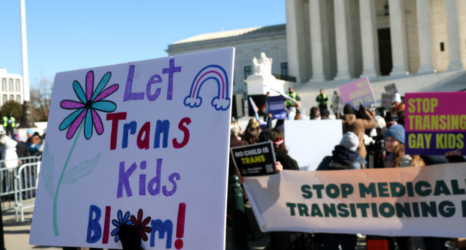“No person in the United States shall, on the basis of sex, be excluded from participation in, be denied the benefits of or be subject to discrimination under any educational programs or activity receiving federal financial assistance.” So says the historic preamble to the Title IX amendment, passed in 1972, passed 45 years ago today.
Title IX has created a space in schools where women and girls are able to feel safe, provided for and empowered. Before Title IX came into effect, the inclusion of women in academia and athletics was minimal—and those who had opportunities to participate were not granted any rights protecting them from harassment, assault or discrimination based on their gender. With the passage of Title IX came the advancement of women and girls, and the pathway to further victories against sex discrimination.
These are just nine of the gains women have seen thanks to Title IX.
#1: More Spaces—and Successes—for Women in Academia
The most obvious gain women made through Title IX was the legal right to participate equally in academia, and now graduation and completion gap has been defeated. In 1971, before Title IX, only 18 percent of women college students were completing at least four years of college, compared to 26 percent of men during that time. Since Title IX was brought into action, women now graduate and enroll in college at a much higher percentage than men, and are earning masters and law degrees at record numbers. When women are given the chance to excel and provided with the materials they need to feel as though they are an important part of the school, they are more likely to want to engage in academia and extra-curriculars.
#2: Pathways to Justice
Schools must now have an established procedure for handling complaints of sexual discrimination, harassment or violence. Prior to Title IX, school could brush away complaints made by students at the advisors discretion, and were not required to take action. They often tried to get the survivor and the attacker to ‘mediate’ with each other rather than file a lawsuit. Schools now must have a thorough procedure for handling complaints that come to their office, and are required to look aver the case regardless of their bias or belief system. This makes for a faster process opposed to a long drawn-out trial or discussion that often force survivors to re-live their traumatic experience.
#3: Responsive Administrators
Under Title IX, schools are legally required to respond to and remedy hostile educational environments. This means that if any person, no matter their gender identity or sexual orientation, feels unsafe or feels as though their education is being negatively impacted by a situation happening at the school, administrators must address it. As many as 32 percent of students who experienced harassment reported not wanting to return to school. Because harassment and assault disproportionately effect women, Title IX requires schools to take action and get involved if they see students are in hostile learning environments. If a complaint is filed with the school, they must be compliant and proactive in investigating the issue at hand.
#4: …And Accountable Administrators
Title IX grants survivors of sexual assault numerous necessary rights. If a student comes forward to administration about their assault the school is required to investigate it whether or not law enforcement is involved. They must provide counseling, medical, and academic support systems to the survivor so they may still succeed in their education. Schools are also required to adopt any known freelance procedures and follow through within a timely fashion. Survivors of sexual assault are not allowed to be suspended or expelled for their trauma experience.
#5: The Language to Describe Harassment and Discrimination
Title IX defines actions that may be described as harassment or gender-based discrimination. Without a definition, it was up to schools to decide what they believed counted as harassment or discrimination of another student. Title IX outlines what schools must include under their discrimination policy, including actions such as interfering with a students birth control, physically or emotionally threatening students, revenge porn, stalking, and sexual assault. These definitions of harassment allow women to feel safe coming forward as they know the issue cannot be knocked down and turned away by school administration.
#6: Equal Athletic Opportunities for Women
School athletic departments must now provide equal opportunity for women to play on a sports team, as well as provide athletic scholarships to women. Before Title IX, one of the few sports women could participate in was cheerleading. Title IX has brought an array for sport opportunities to the table for women students, as schools are required to accommodate any woman who wishes to participate in athletics and make sure they are not discriminated against when they choose to join a team. The involvement of women and girls in athletics has soared since Title IX passed, including a 600 percent increase in college sports participation.
#7: Support for Pregnant and Parenting Women and Teens
Schools are required to make accommodations for pregnant women or mothers under Title IX. Almost 70 percent of pregnant teenagers leave or drop-out of school, highly due to lack of accommodation or acceptance by peers. Whether it be participating in an extra-curricular or enrolling in an honors course, a school must now allow pregnant students or mothers to have access to the same educational experiences that all other students have. They must also provide excused absences if the woman has a medical appointment, and provide expectant students with accommodations to make their time at school more comfortable during pregnancy. This could include a larger desk space, an elevator key or allowing more frequent trips to the restroom.
#8: Safeguards for Survivors
Before Title IX, schools did not require separation of survivors and their abusers. Now, schools must ensure that survivors of sexual assault, rape or domestic violence, do not share spaces such as dorms or classrooms, with their attacker. If brought to the schools attention, they are now required to relocate either the attacker or the victim of the assault in order to lessen the chances that trauma will be endured again. Seeing the person who attacked you can overly impact your emotional health and wellbeing, so Title IX helped to create a safer space for many women and student survivors
#9: Protections for LGBTQ+ Students
Nearly half of all students under the LGBTQ acronym experience bullying or sexual violence during their lifetime. Title IX requires schools to treat any complaint filed by these students with the same severity and urgency they would anyone else. They must support the survivor of any attack with their academic completion, and provide them with the same counseling services offered to all other students. Transgender students are still protected under Title IX, regardless of what the Trump administration wants to believe. They are still required to be given accommodations that align with their gender identity.
The Trump administration and the GOP are hellbent on watering down and dismantling Title IX. The Republican Party platform in 2016 was explicit about their agenda to do so. But we won’t go back. Title IX has given women the tools they need to empower, protect and defend themselves in hostile environments and succeed in academia and athletics—and it has changed the lives and futures of millions in under a century.
Today, and every day, we celebrate the progress we’ve made under this landmark law—and look forward to seeing what steps we take next toward equality for all.





